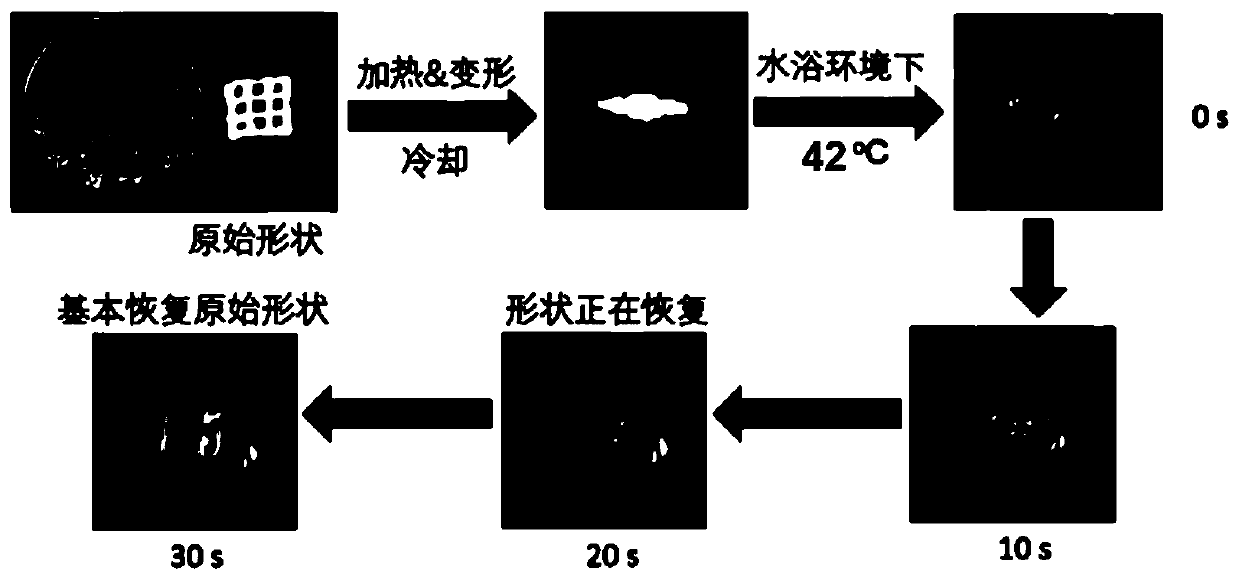Photo-thermal chemotherapy bone repair material and preparation method of tissue engineering scaffold
A technology for tissue engineering scaffolds and bone repair, applied in tissue regeneration, medical science, prostheses, etc., can solve the problems of limiting the long-term anti-cancer ability of scaffolds, low stability of non-toxic photothermal preparations, and high toxicity of photothermal preparations , to achieve good new bone induction and regeneration ability, excellent tumor cell killing effect, and excellent bone conduction effect
- Summary
- Abstract
- Description
- Claims
- Application Information
AI Technical Summary
Problems solved by technology
Method used
Image
Examples
Embodiment 1
[0041] A photothermal chemotherapy bone repair material, including 90 parts of oil-soluble polymer material, 60 parts of bioceramic powder, 100 parts of oily solvent, 1 part of water-soluble bioactive material, 18 parts of water, 4.5 parts of emulsifier, and 0.6 parts of chemotherapy drug part, 0.6 part of photothermal preparation. The mass-volume ratio of the photothermal preparation to the oily solvent is greater than 0 and less than 0.01g / ml; the mass-volume ratio of the bioceramic powder to the oil-soluble polymer material is 1-2.5; the mass-volume ratio of the water-soluble bioactive material to water is greater than 0 is less than or equal to 0.05 g / ml; the mass volume ratio of emulsifier to water is greater than 0 and less than 0.05 g / ml, and the mass volume ratio of chemotherapeutic drugs to water or oily solvent is greater than 0 but less than 0.05 g / ml.
[0042] Wherein, the oil-soluble polymer material is polylactic acid-polytrimethylene carbonate PLA-PTMC, the phot...
Embodiment 2
[0051] A photothermal chemotherapy bone repair material, including 30 parts of oil-soluble polymer material, 60 parts of bioceramic powder, 100 parts of oily solvent, 0.1 part of water-soluble bioactive material, 20 parts of water, 1 part of emulsifier, and 0.9 parts of chemotherapy drug 1 part of chemotherapy drug, 5 parts of photothermal preparation. The mass-volume ratio of the photothermal preparation to the oily solvent is greater than 0 and less than 0.01g / ml; the mass-volume ratio of the bioceramic powder to the oil-soluble polymer material is 1-2.5; the mass-volume ratio of the water-soluble bioactive material to water is greater than 0 is less than or equal to 0.05 g / ml; the mass volume ratio of emulsifier to water is greater than 0 and less than 0.05 g / ml, and the mass volume ratio of chemotherapeutic drugs to water or oily solvent is greater than 0 but less than 0.05 g / ml.
[0052] Among them, the oil-soluble polymer material is polylactic acid-glycolic acid (PLGA),...
PUM
 Login to View More
Login to View More Abstract
Description
Claims
Application Information
 Login to View More
Login to View More - R&D
- Intellectual Property
- Life Sciences
- Materials
- Tech Scout
- Unparalleled Data Quality
- Higher Quality Content
- 60% Fewer Hallucinations
Browse by: Latest US Patents, China's latest patents, Technical Efficacy Thesaurus, Application Domain, Technology Topic, Popular Technical Reports.
© 2025 PatSnap. All rights reserved.Legal|Privacy policy|Modern Slavery Act Transparency Statement|Sitemap|About US| Contact US: help@patsnap.com



